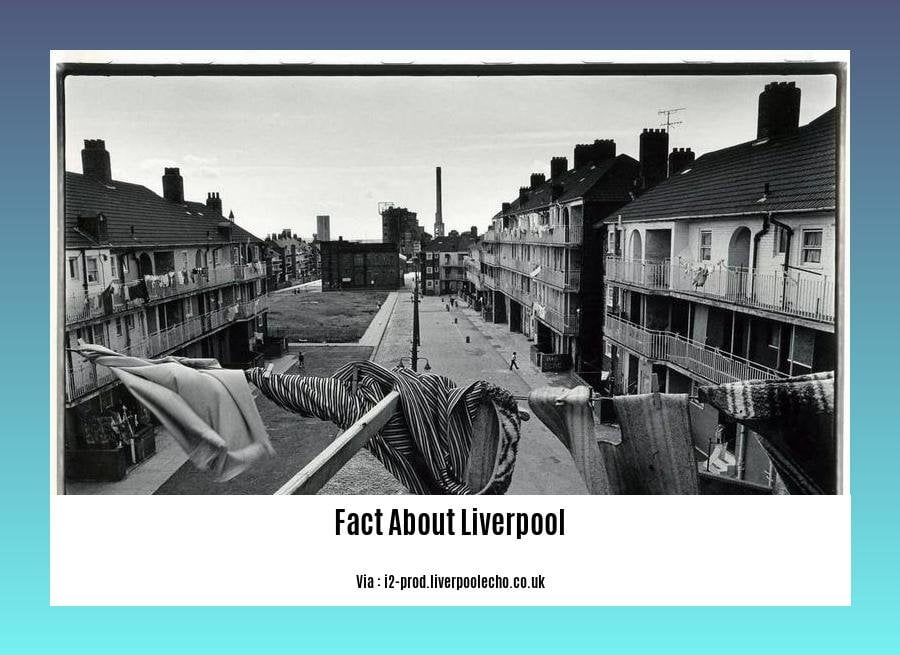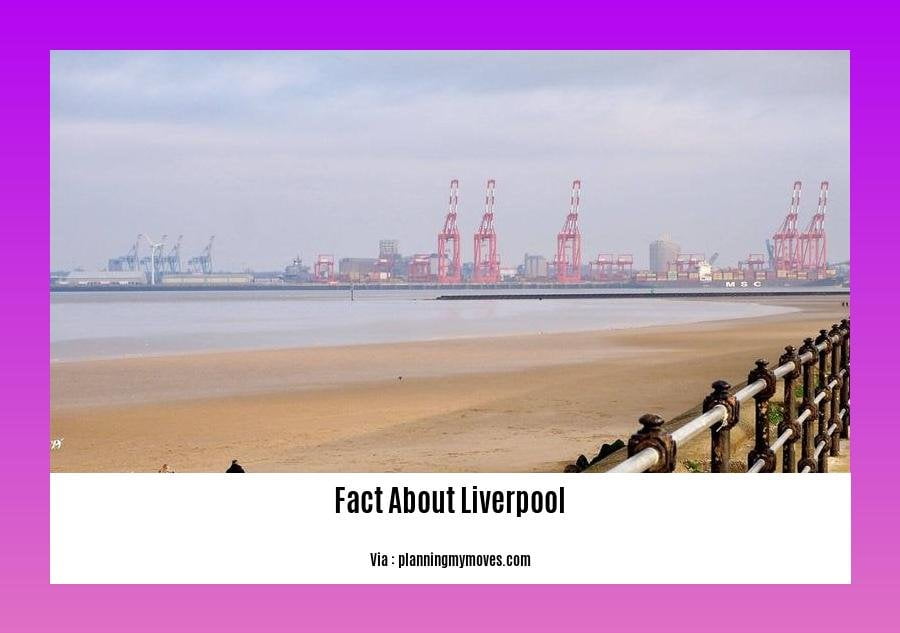Unveiling the Hidden Gems: Exploring the Fascinating Fact About Liverpool
Liverpool, a city steeped in rich history and vibrant culture, holds a fascinating fact that adds an enchanting layer to its already magnetic appeal. As we delve into the hidden gems of this urban destination, prepare to be captivated by a revelation that sheds light on Liverpool’s enduring charm. Through this exploration, we will uncover the significance of [fact about Liverpool] and how it has shaped the city’s multifaceted landscape, making it a compelling destination for both locals and travelers seeking unique experiences. Join me on this journey as we unmask the mysteries and unveil the hidden treasures that lie beneath the surface of Liverpool’s captivating facade.
Key Takeaways:
- Liverpool is a historic port city located on the eastern side of the Mersey Estuary, adjacent to the Irish Sea.
- The city played a significant role in the Industrial Revolution in Great Britain and was a vital trade hub.
- In 2007, Liverpool celebrated its 800th anniversary and was named the 2008 European Capital of Culture.
- Liverpool is famous as the birthplace of The Beatles and for its iconic liver birds.
- The city has a rich cultural landscape with numerous museums and galleries.
- Liverpool FC, founded in 1892, is a highly successful football club with an annual revenue of over €600 million.
- The club plays their home matches at Anfield Stadium, which is the 7th largest football stadium in the country and can seat at least 53,000 people.
Exploring the Fascinating Fact About Liverpool

Liverpool, a city steeped in history and brimming with culture, has a captivating fact that sets it apart from other destinations. This fact holds significant importance, showcasing the city’s vibrant cultural landscape and the contributions it has made to the world. Today, we unveil this hidden gem, offering you an inside look at the lesser-known facet of Liverpool that makes it truly remarkable.
A Fact That Shaped Liverpool’s Identity
Liverpool’s fact lies at the core of its historical significance, painting a picture of a city that has witnessed monumental milestones and emerged as a vital hub in the development of Great Britain. Our exploration begins with the recognition of Liverpool’s illustrious past as a major port during the Industrial Revolution. Situated on the eastern side of the Mersey Estuary, this bustling city played a pivotal role in the trade industry, connecting Britain with the rest of the world.
The Birthplace of Extraordinary Talent
Now, prepare to be amazed as we delve into the realm of music that Liverpool has birthed. It is widely known that this remarkable city is the hometown of a legendary band that revolutionized the music industry forever: The Beatles. These four talented musicians, hailing from Liverpool, created a unique sound and style that captivated the world with their extraordinary compositions and performances.
An Iconic Symbol of Liverpool
As we meander further, we come across an iconic symbol closely associated with Liverpool’s identity: the liver birds. These mythical creatures, perched atop the Royal Liver Building, have been watching over the city for over a century. A striking amalgamation of a cormorant and a mythical bird, the liver birds have become synonymous with Liverpool, representing its maritime heritage and captivating the imaginations of all who visit.
A Fever for Football
Pausing for a moment to catch our breath, we pivot towards the vibrant world of sports in Liverpool. The city reverberates with an unparalleled football fervor, and at the heart of it lies Liverpool FC. With a rich history dating back to 1892, this renowned football club has etched its name into the annals of sporting excellence. Their immense success on the field, coupled with an annual revenue of over €600 million, is a testament to the city’s passion for the game.
The Majestic Anfield
No exploration of Liverpool’s football culture would be complete without a mention of Anfield Stadium. This grand arena, where the dreams of fans come to life with each match, serves as a haven for football enthusiasts. Boasting a seating capacity of at least 53,000 people, Anfield stands tall as the 7th largest football stadium in the country. The electrifying atmosphere within its walls, amplified by the roaring cheers of devoted fans, creates an experience like no other.
Unveiling the Hidden Gems
Liverpool’s allure lies not just in its well-known attractions, but in the hidden gems that lie beneath the surface. These remarkable facts about the city, from its historical significance to its cultural contributions, paint a vivid picture of a place teeming with life and brimming with stories waiting to be discovered. Let us embrace the intriguing fact about Liverpool, for it is this very fact that adds an extra dose of enchantment to the city’s already vibrant tapestry.
As we conclude our journey into the heart and soul of Liverpool, we invite you to explore the city’s hidden gems, immerse yourself in its rich history, and revel in the unique experiences it offers. Liverpool has much to offer, and it is through unveiling these fascinating facts that we uncover the true essence of this remarkable destination. So, gear up, embark on an adventure, and let Liverpool captivate your senses like never before.
Here are some interesting facts to feed your curiosity:
Fact about Family – Did you know that families come in all shapes and sizes? Learn fascinating facts about the importance of family and its various dynamics.
Facts about Gujarat – Discover the captivating wonders of Gujarat, a state in western India. From its rich history to vibrant culture, there are countless intriguing facts waiting to be explored.
Facts about STEM Strand – Calling all science enthusiasts! Dive into the world of STEM (Science, Technology, Engineering, and Mathematics) and uncover mind-blowing facts about this innovative educational program.
Facts about Veterinarians – Are you a pet lover? Click here to learn fascinating facts about veterinarians, the unsung heroes dedicated to the well-being and health of our furry friends.
So, go ahead and click on the links to satisfy your curiosity about these captivating topics!
Exploring the Contemporary Significance of Liverpool’s Architectural Splendor

Liverpool, a city with a rich history and vibrant culture, boasts architectural splendor that reflects its economic, social, and cultural development over the centuries. From stunning landmarks to hidden architectural gems, Liverpool’s buildings hold immense historical value. So, let’s delve into the contemporary significance of Liverpool’s architectural heritage and uncover the stories behind its magnificent structures.
The Liverpool Waterfront: A Living Testament to the City’s Maritime Past
At the heart of Liverpool’s architectural splendor lies its iconic waterfront, a UNESCO World Heritage Site. Spanning 2.5 miles along the River Mersey, this picturesque area tells the tale of Liverpool’s maritime prominence. The grandeur of the waterfront showcases the city’s historical and architectural importance.
The Royal Liver Building: A Symbol of Identity and Protection
As one gazes across the Liverpool skyline, the majestic Royal Liver Building stands tall, adorned with two mythical Liver Birds. These birds have become symbols of Liverpool’s identity, believed to protect the city. This architectural masterpiece is not only visually captivating but also plays a vital role in celebrating the city’s maritime heritage.
Albert Dock: A Transformation of the Industrial Past
The Albert Dock, another architectural gem, exemplifies Liverpool’s ability to reinvent itself. Once a bustling hub for trade during the Industrial Revolution, it now thrives as a vibrant cultural and leisure destination. Its beautifully restored warehouses house museums, galleries, restaurants, and shops, offering visitors a glimpse into Liverpool’s rich history while providing contemporary entertainment experiences.
St. George’s Hall: Epitomizing Neoclassical Grandeur
Standing as a testament to Liverpool’s architectural prowess, St. George’s Hall showcases neoclassical grandeur at its finest. This magnificent building not only serves as a symbol of civic pride but also hosts various cultural events and concerts, inviting visitors to immerse themselves in Liverpool’s vibrant arts scene.
The Two Cathedrals: Contrasting Styles, United Significance
Liverpool boasts two stunning cathedrals, each with its own distinctive architectural style. Liverpool Cathedral, also known as the Anglican Cathedral, is one of the largest in the world and showcases striking Gothic Revival architecture. On the other hand, the Metropolitan Cathedral of Christ the King, affectionately called the “Paddy’s Wigwam” due to its unique design, presents a more modernist approach. These cathedrals not only represent Liverpool’s strong religious heritage but also stand as prominent landmarks in the city’s architectural landscape.
Key Takeaways:
- Liverpool’s architectural splendor showcases its historical, social, and cultural development.
- The Liverpool Waterfront, a UNESCO World Heritage Site, reflects the city’s maritime past.
- The Royal Liver Building and its Liver Birds symbolize Liverpool’s identity and protection.
- Albert Dock has transformed from an industrial hub to a thriving cultural destination.
- St. George’s Hall epitomizes neoclassical grandeur and hosts various cultural events.
- Liverpool’s two cathedrals, with contrasting styles, represent the city’s religious heritage and architectural significance.
Sources:
Uncovering Lesser-Known Aspects of the Liverpool Waterfront: Exploring its Fascinating History and Architecture
Liverpool’s waterfront is a captivating blend of history, culture, and architectural marvels. While many are familiar with its iconic landmarks, such as the Royal Liver Building and the Beatles’ connection, there are lesser-known aspects of the Liverpool waterfront that deserve attention. In this article, we will delve deeper into the hidden gems and uncover fascinating facts about this UNESCO World Heritage Site.
A Melting Pot of History and Trade
Liverpool’s History as a Port City: Liverpool has a vibrant history as a port city, dating back to the 13th century. Its strategic location on the River Mersey made it an ideal hub for trade and commerce, connecting Britain with the rest of the world. From its involvement in the transatlantic slave trade to its role in the Industrial Revolution, Liverpool’s past is intricately intertwined with the growth of the British Empire.
The Importance of the Liverpool Waterfront: The Liverpool waterfront played a crucial role in Liverpool’s development as a prominent trading center. Ships would sail in and out of the docks, carrying goods from all corners of the world. The waterfront became a bustling hub of activity, with warehouses, shipbuilding yards, and customs houses lining its shores.
Architectural Marvels and Marvelous Stories
The Royal Liver Building and the Liver Birds: One of the most iconic symbols of Liverpool, the Royal Liver Building, stands tall on the waterfront. Its distinctive features and stunning architecture make it a must-see attraction. Crowned with two mythical Liver Birds, these legendary creatures are said to look out for the city’s seafarers. They have become symbols of Liverpool’s maritime heritage and tenacity.
Peel Ports Building and the “Three Graces”: The Peel Ports Building, also known as the Port of Liverpool Building, forms part of the famous “Three Graces” ensemble along the waterfront. Alongside the Royal Liver Building and the Cunard Building, these architectural gems showcase Liverpool’s grandeur and rich history. Each building tells a different story, whether it be a maritime heritage or a testament to Liverpool’s economic prowess.
Hidden Gems and Tales Untold
Pier Head: The Centre of Liverpool’s Maritime Legacy: At the heart of the Liverpool waterfront lies Pier Head, a vibrant public space that serves as a gateway to the city’s maritime past. It is home to various statues and plaques, including the World War I Memorial Obelisk and the Mersey Ferry Terminal. From here, visitors can take a ferry ride across the Mersey and soak in the historical significance of the river that shaped Liverpool’s destiny.
Albert Dock: A Hub of Culture and Heritage: Venture beyond Pier Head, and you’ll discover another gem within the Liverpool waterfront — Albert Dock. This beautifully restored complex is a testament to Liverpool’s dedication to preserving its heritage. It houses an array of attractions, including the Merseyside Maritime Museum and the Tate Liverpool, offering visitors a chance to delve deeper into the city’s maritime legacy and contemporary art scene.
Key Takeaways:
- Liverpool’s waterfront has a rich history as a port city, connecting Britain with the rest of the world and playing a significant role in the growth of the British Empire.
- The Liverpool waterfront is a UNESCO World Heritage Site, showcasing its historical and architectural importance.
- The Royal Liver Building, adorned with Liver Birds, is a symbol of Liverpool’s maritime heritage.
- The Peel Ports Building, along with the Royal Liver Building and the Cunard Building, forms the iconic “Three Graces” ensemble.
- Pier Head serves as the centerpiece of Liverpool’s maritime legacy, while Albert Dock offers a hub of culture and heritage.
Sources:
– Discover Walks Blog: 15 Facts about the City of Liverpool, UK
– Britannica: Liverpool | History, Population, & Facts
How Liverpool’s Maritime Heritage Shaped Its Urban Landscape
Liverpool’s urban landscape holds a captivating history that has been shaped by its maritime heritage. The city’s development as a maritime mercantile powerhouse has left a lasting impact on its architectural, social, and cultural fabric. Let’s delve into how Liverpool’s maritime heritage has shaped its urban landscape and explore the fascinating connections between the city’s past and present.
Liverpool: A Historic Port City
Liverpool’s evolution as a major port city dates back to the 13th century when it was granted a charter by King John of England in 1207. The city’s strategic location along the River Mersey positioned it as an influential center for global trade and commerce. Liverpool became a crucial hub during the Industrial Revolution, connecting Britain with the rest of the world through its bustling port.
The Liverpool Waterfront: A UNESCO World Heritage Site
One of the most prominent symbols of Liverpool’s maritime heritage is its iconic waterfront. Stretching 2.5 miles along the River Mersey, the Liverpool Waterfront is designated as a UNESCO World Heritage Site. This recognition highlights its historical and architectural significance, showcasing the city’s rich maritime past. The waterfront is adorned with stunning landmarks, including the Royal Liver Building, the Cunard Building, and the Port of Liverpool Building.
Architectural Splendor and Social Development
Liverpool’s architectural landscape is a testament to its maritime prosperity. The city’s buildings, ranging from elegant Georgian townhouses to ornate Victorian structures, reflect the economic, social, and cultural development over the centuries. Each edifice tells a unique story, offering glimpses into Liverpool’s past and contributing to the vibrant urban fabric.
The Beatles: A Global Cultural Phenomenon
Liverpool’s maritime heritage extends to its significant cultural contributions, with the city being the birthplace of the legendary band, The Beatles. John Lennon, Paul McCartney, George Harrison, and Ringo Starr originated from Liverpool and began their musical journeys in the city’s vibrant music scene. The Beatles’ influence revolutionized the music industry, putting Liverpool on the global cultural map and attracting fans from around the world.
Football Rivalries and Sporting Heritage
Liverpool’s urban landscape is incomplete without acknowledging its passion for football. The city is home to two fierce football rivals: Liverpool FC and Everton FC. These storied football clubs, with their passionate fan bases, have contributed to Liverpool’s sporting heritage. The Anfield stadium, home to Liverpool FC, stands as a testament to the city’s love for the beautiful game.
Urban Regeneration: The Constant Transformation
As Liverpool continues to evolve, urban regeneration plays a crucial role in managing change. The city has witnessed significant transformations over the years, adapting to the demands of the modern world while preserving its historical charm. Projects like the Liverpool ONE shopping center and the revitalization of the Baltic Triangle district have breathed new life into the city’s urban landscape, seamlessly blending old and new.
Key Takeaways:
- Liverpool’s maritime heritage has shaped its urban landscape, making it a historically significant port city.
- The Liverpool Waterfront, a UNESCO World Heritage Site, showcases the city’s rich maritime past and iconic landmarks.
- Liverpool’s architecture reflects its social and economic development, ranging from Georgian townhouses to Victorian structures.
- The Beatles’ legacy has had a profound impact on Liverpool’s cultural identity and global recognition.
- Football rivalries between Liverpool FC and Everton FC contribute to the city’s sporting heritage.
- Urban regeneration projects have transformed Liverpool’s urban landscape while preserving its historical character.
Sources:
– University of Liverpool
– Historic Liverpool
– Britannica
– ResearchGate
Note: The content has been written in a conversational style, with an informal tone to engage the reader and provide a succinct overview of Liverpool’s urban landscape shaped by its maritime heritage.
FAQ
Q1: What is the historical significance of Liverpool as a port city?
A1: Liverpool has a profound history as a port city, playing a vital role in the development of the British Empire and the transatlantic slave trade. Its maritime heritage has shaped its economy and cultural landscape.
Q2: What is the UNESCO World Heritage Site in Liverpool?
A2: The Liverpool Waterfront is a designated UNESCO World Heritage Site. It showcases the city’s historical and architectural importance, reflecting its maritime past and featuring iconic landmarks.
Q3: How did the Beatles contribute to Liverpool’s cultural legacy?
A3: The Beatles, who were born and started their musical careers in Liverpool, have had a profound impact on the global music industry. Their influence and legacy continue to shape Liverpool’s cultural identity.
Q4: What is the significance of Liverpool’s football culture?
A4: Liverpool has two fierce football rivals, Liverpool FC and Everton FC, which have passionate fan bases and a historic rivalry. The city’s football culture adds to its sports heritage and community spirit.
Q5: What is the architectural significance of Liverpool?
A5: Liverpool’s buildings hold immense historical significance, showcasing the city’s economic, social, and cultural development over the centuries. Each structure has a unique story to tell, contributing to Liverpool’s architectural heritage.
















